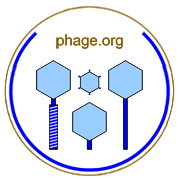

Phages that are able to recombine with phage lambda, producing viable progeny.
This is homologous recombination, i.e., that which readily occurs given phage-cross experiments. The implication is of similar genome architecture and otherwise sequence homology between phages, though that sequence homology does not necessarily extend to all of the genes found between two phage isolates. Note that having this definition based upon homologous recombination does not preclude illegitimate recombination between phages but rather illegitimate recombination is less definitive in defining lambdoid status though nonetheless may be more likely, in terms of recombinant survival, given such similarity in genome architecture.
A less strict definition of lambdoid can be sequence based, that is, phages possessing similar genome architecture along with sequence homology to phage lambda but without homologous recombination between phages necessarily experimentally demonstrated. Alternatively, the concept of lambdoid phages is not a description of virion morphology though virion morphologies are often but not always similar among lambdoid phages to that of phage lambda (λ).
Relevant to the latter, note from Janekovic et al. (1983), p. 44, "Though completely different both in protein and DNA restriction fragment patterns, the three viruses also resemble each other in their lysogenic states, which are all subject to lysis induction by sulfur depletion, as well as in their principal structures: outer envelope, inner helical core, linear double-stranded DNA. They must thus be considered a family as for example the T-even or the lambdoid phages." That is, these archaeal viruses should be considered to, at best, be presumptively similar to each other in a lambdoid sense but with lambdoid-like similarity not actually demonstrated in this case, that is, recombinant progeny of virus crosses had not actually been demonstrated.
From Stahl (1989), p. 245, "I later suggested (STAHL 1967) that recombination between lambdoid phages in nature may occur most frequently between a prophage and a heteroimmune superinfecting phage."
From the glossary of Hershey (1971), p. 775, this is a definition of "Lambdoid": "Related to λ (said of a group of phages able to form recombinants with λ)."
For more on this topic, see Wikipedia, Google, and PubMed. Contact web master. Return to terms.